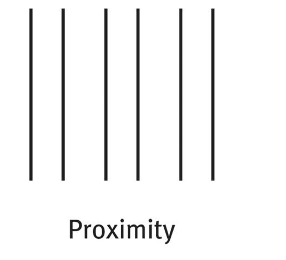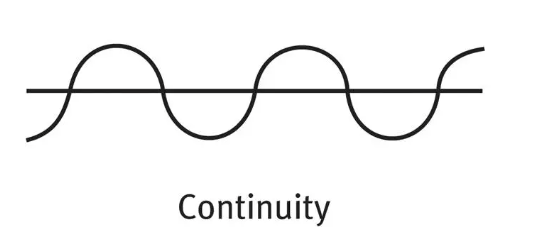sensation + perception
sensation: process by which our sensory receptors + nervous system receive + represent stimulus energies from environment
perception: process of organizing + interpreting sensory info, recognize meaningful objects+events
bottom-up processing - analyzing stimulus begins with sense receptors + works up to level of brain + mind
→ what am i seeing?
top-down processing - processing info based on prior knowledge, experiences, expectations
→ is this something i have seen before?
signal detection theory
- we detect meaningful info (signals) from noisy stimuli based on past experiences/expectations
- focus on most important signal, tunig out rest (ex. footsteps in dark parking lot)
selective attention:
- process of discriminating what is and is not important when focusing awareness on particular stimulus.
- influenced, by motivation, past experiences, culture, bio
- perceptions abt objects change moment to moment
→ cocktail party effect: ability to tune into single voice despite many coversations in a noisy room
- we can hear our name in a crowd, even during separate convo
- much more difficult for people who cant hear out of both ears
inattentional blindness: inability to see object/person in our midst bc we are focused on smth else
ex. person driving car may fail to notice smaller events happening around them
→ simmons + chabris
change blindness: failing to notice changes in the environment
ex. fails to notice person they are talking to has been swapped w another during brief interruption
transduction: transformation of stimulus energy into neural impulses (neurons that transmit info through body)
ex. light enters eye + converted into signals in retina, then sent to brain as visual info
psychophysics: study of relationship between physical characteristics of stimuli (like frequency intensity) + our perceived sensation (hearing the frequency)
- by gustav fechner
- determine if person can hear frequency, increasing until person can hear
sensory system steps
1. receive sensory info from environment
2. transform that info into energy inpulses
3. deliver neural info to brain
threshold: diving line between what has detectable energy vs what does not
ex. how much movement needed for light sensors, how much smoke for smoke alarms
absolute threshold (exists): minimum stimulation needed to detect a particular stimulus 50 percent of time (to be aware of stimulus happening)
ex. min amt of light needed for someone to see a flicker in dark room
subliminal threshold (less): stimuli below one’s absolute threshold for conscious awareness, the stimuli u cannot detect 50 percent of time
ex. message flashing so quickly on screen, audience doesnt notice
difference threshold (change): min amt of stimulus needed to show noticeable change
→ greater the intensity of stimulus, greater the change needed to be perceived
ex. picking up 5 lb weight feels very diff from 10 lb weight
you CAN be affected by stimuli so weak that you dont consciously notice them
- unnoticed image/word can reach visual cortex and briefly prime response to later question
ex. flashed image of kitten, one flashed image of werewolf, then replaced by image of people. people looked nicer if flashed positive scenes, even if they were not aware
priming: person’s response to stimulus can be influenced by previous unconscious stimulus
weber’s law: to be perceived as diff, two stimuli must differ by constant minimum percentage
ex. 2 lights must differ in intensity by 8 percent, two objects differ weight by 2 percent, two tones differ in frequency by 0.3 percent
sensory adaptation: when we are constantly exposed to stimulus that does not change, we become less aware of it
→ does not apply for vision bc eyes constantly move
→ more attentive to new potentially dangerous sensations
ex. smell from neighbors’ house, within minutes u no longer notice
MODULE 17
perceptual set
- we perceive world that align w our mood, experiences, expectations
- alter interpretation of our environment
once we form wrong impression of situation, it is hard to correct it
→ sight, taste, smell, hearing through top down processing
ex. hearing: pilot looked over at sad co pilot and said “cheer up”, copilot expects to hear “gear up” and raises the wheels
context effects
influence of environmental factors on how people perceive/interpret stimuli
ex. “eel is on the wagon” would make you perceive the first word as wheel
ex. person picks black couch of diff design when next to 2 similar navy couches, even if black is more expensive/ lower quality
emotion + motivation
- hearing sad music make people perceive a sad meaning to words like mourning instead of morning, die instead of dye
ex. walking destinations look farther to those who are tired, injuries hurt more when we are upset
motives cause us to perceive needed object as more or less attractive or accessible
- water bottle when thirsty seem closer, energizing motivation to go for it
MODULE 18
wavelength: distance from peak of one light/sound wave to the peak of next
frequency = how many wavelengths can fit in certain section
- short wave length = high frequency (bluish colors, high pitched sounds
- long wavelength = low frequency (reddish colors, low piotched sounds)
- high amplitude (bright colors, loud sounds)
- small amplitude (dull colors, quiet sounds)
hue: dimesion of colors determined by wavelength of light (what we know as color names)
intensity: amount of energy in light waves (determined by amplitude) influencing brightness
The Eye
bipolar cells: nerve cells in retina, link photoreceptor cells (rods, cones) to ganglion cells which send visual signals to the brain
ganglion cells: output neurons in the retina that transmit visual into the brain
optic nerve: made up of axons from the ganglion cells
→ send signals to occipital lobe , thalamus distributes that info
there are no receptor cells where the optic nerve leaves the eye
= blind spot
fovea: focus point of the retina, surrounded by cones, help with fine detail vision
feature detectors: nerve cells in the brain tha trespond to specific features of stimulus, such as shape, angle, movement
‘for ex. without feature detectors, you wouldnt notice a round baseball flying at you
parallel processing: ability to do many things at once
Visual Info Processing
Environmental stimulus → retinal processing (rods, cones, bipolar cells, ganglion cells) → feature detection (respond specific features, like edges, lines, angles) → parallel processing (process combined info about motion, form depth, color) → recognition (brain interprets constructed image based on info from stored image)
theories for perceiving color
trichromatic theory: we receive three colors (Red blue green), combination determines the color we see
→ color deficient vision lack functioning red or green sensitive cones
opponent process theory: focuses on color perception in brain rather than in eyes
- opposing retinal process enable color vision
red-green, blue-yellow, black-white
color blindness: deficiency of cones on fovea
MODULE 19
gestalt: an organized whole
- gestalt psychologists emphasized putting pieces of info into meaningful whole
figure-ground: how people visually differentiate figure with background
ex. when reading, black words are the figure, white paper is the ground
grouping: tendency to organize stimuli into groups
- proximity: group figures that are nearby together
- continuity: perceive smooth continuous patterns rather than discontinuous ones (continuous lines instead of semicircles)
-closure: we fill in gaps to create a complete whole object



depth perception: estimate of object’s distance from us, able to see in 3d
ex. distance of oncoming car, height of a house
visual cliff: to test depth perception in infants and young animals
binocular cues: depth cues, such as retinal disparity, that depend on the use of both eyes
retinal disparity: the diff between the view that each eye receives of an object or scene
monocular cues: unlike retinal disparity, able to be perceived using one eye
- relative height = objects higher in field seem farther
- relative motion = as we move, objects that are actually still may appear to mvoe
- relative size = if we assume two objects are similar in size, we perceive the one that appears smaller to be farther away
- interposition = if something blocks our view of another, we perceive it as being closer. covered object seems farther away
linear perspective = parallel lines appear to meet in the distance ex. long highway seems to meet
- light + shadow = shading produces a sense of depth consistent with assumption that light comes from above
phi phenomenon: illusion of movement created when two or more adjacent lights blink and off ex. halloween house video
perceptual constancy: perceiving objects as unchanging (consistent shapes, size, brightness, color) even as illumination + retinal images change
color constancy: perceiving familiar objects as having consistent color
ex. apple will still look red on a sunny or cloudy day
audition: sense or act of hearing
frequency: how many wavelengths that pass a point in a given time
pitch: lowness or highness of a tone, depending on frequency
the ear
sound waves enter outer ear → waves travel through auditory canal to eardrum, causing it to vibrate → in middle ear (hammer anvil, stirrup) three bones transmit vibration to the cochlea in inner ear → cochlea moves liquid from vibrations → hair cells in cochlea bend → triggers impulses in nerve cells → axons of those cells form the auditory nerve → sends neural messages to auditory cortex in brain’s temporal lobe
sensorineural hearing loss: damage to cochlea’s hair receptor cells
→ bio changes like heredity, aging, exposure to earsplitting noise
→ if sound goes over 100 db
- only way to restore hearing is with cochlear implant
cochlear implant : device for converting sounds into electrical signals + stimulate auditory nerve through electrodes in coclea
conduction hearing loss: damage to mechanical system that conducts sound waves to cochlea
→ can be treated most times
theories on pitch perception
place theory: we hear different pitches bc different sound waves trigger activity at diff places along cochlea’s basilar membrane
- narrow tip is for low frequency, low pitch
- opening of basilar membrane for high pitch
frequency theory: sound that is heard is matched by same amt of nerve impulses
ex. frequency of 100 hZ = 100 impulses transmitted through auditory nerve to brain
we locate sounds
sound waves strike one ear sooner and more intensely than the other
touch (somesthetic)
- skin is largest sensory system
- pressure, warmth, cold, pain
phantom limb sensations: feeling that amputated limb is still present
pain:
nociceptors - respond to mechanical, heat, chemical
pain info brought to brain in 2 systems
1. fast pathways send info to cortex in fraction of sec (ex, receive shot)
2. slow pathways send info through limbic system, takes longer (ex aching)
taste (gustation): 10,000 taste buds replaced every 2 weeks
- sweet, salty, sour, bitter, olegustus, umami
smell (olfaction): molecules in air enter nasal passage, reach receptor cells in upper nasal passage
→ send msgs to olfactory bulb, then to smell cortex in temporal lobe
movement (kinesthesia): allows touching nose + typing
- falling asleep of limbs is temporary failure of kinesthetic sense
vestibular: works with kinesthesia to coordinate position of our body parts in relation to other parts. balance"
→ semicircular canals in inner ear are fluid filled tubes
→ as you move, fluid flows in different directions, signaling position of our body+head
sensory interaction: all our senses influence each other
→ mcgurk effect: bah while seeing mout movement of fah
embodied cognition: idea that brain works with body to process sensations (preferences, judgements)
ex. nervous in ur stomach, not brain
synesthesia: condition in which stimulation of one sensory pathway leads to sensory experiences in a secnod pathway
ex. hear in color or feel a taste